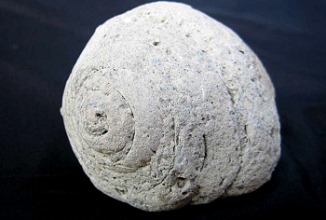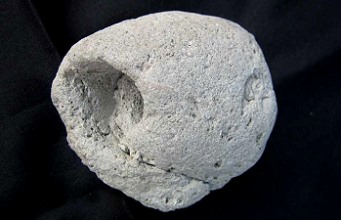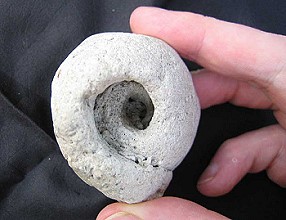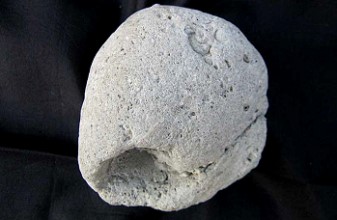|
Discussions:
-
Well your fossil is certainly a gastropod, tough not a "conch"
in the strict sense. Conchs, strictly speaking, make up one of many
gastropod families. From the top, this shell looks more like a turban
shell or top shell than a conch. But the underside with the open
space inside is very unusual, and quite unlike modern tops and turbans.
Also, I believe this fossil is not a "recent" one, that
is to say it's not Pleistocene or Pliocene, and is therefore, I
believe, well over a million years old. We do have a couple of folks
on the list who are quite expert on fossils. If you should receive
more information about your fossil, I'd appreciate it if you could
forward it to me, just for my own information.
Regards, ...Paul M.
-
These look like molds
of shells. That is, if you poured plaster of paris into the shell,
let it set, then broke away the shell, this is what you would get.
Fossils form when the shell dies and falls to the bottom. As sediment
covers them, and in this case, fills them, over time it becomes
lithified (turns to stone). The age of what you have is hard to
dictate without other marker fossils that would indicate an exact
age. Hope this helps. ...Jack D.
-
The obviously coiled form is an internal mold, possibly from
a trochoid gastropod, but there are many groups that look the same
without the shell. The other is possibly the internal mold of a
Conus sp. gastropod.
These shells could be from the Cretaceous to the recent. ...Allen
A.
-
Not having a fossil book infront of me, this is a mold of a
gastropod. ..SD
-
This is a gastropod internal mold. A geologic map would be helpful
in figuring out the age of the snail, but as it doesn't look like
a freshwater species it's probaby at least Miocene. I think there
are good Eocene to Miocene marine beds in that general region; I
have collected marine Miocene in Austria near the Hungarian border.
Such preservation can be found in fossils less than a million years
old (Pleistocene), so it doesn't take too long, from a geologic
perspective, to happen. Most mollusks, as well as some other types
of organisms, make their shells of aragonite. This is a crystal
form of calcium carbonate that is unstable and crumbles away, turning
to calcite, under the right geologic conditions.
The snail is probably a neogastropod. It's a bit hard to tell whether
it is Conus or similar, with the lower part of the internal whorls
not preserved, or whether it is more buccinid-like and has a large
columella. I suspect the former. Internal molds are often hard to
identify. ...Dr. David
C.
-
Pleurotomarriidae indeterminable. ...Andrew G.
|



